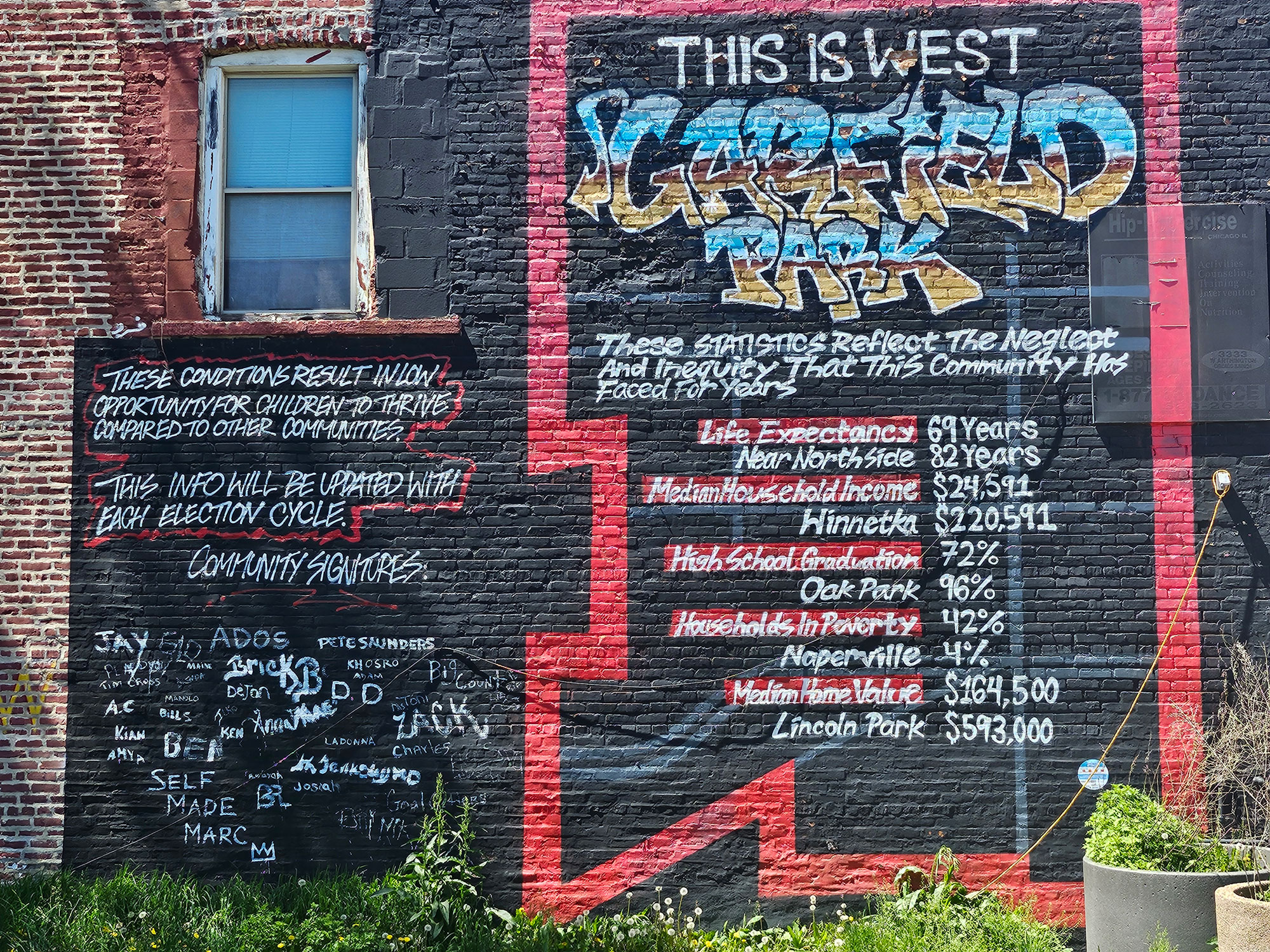West Garfield Park started as a village called Central Park, for the large park to the east, and was renamed West Garfield Park in 1881 following the assassination of President James A. Garfield. It was a residential community with most recreation taking place in the park. The park offered a variety of activities. The conservatory houses exotic plants, there are areas for picnics, and a bicycle track. In 1878 a gentlemen’s club was established, on the west side of the park, complete with a race track for horses. By 1888 the club was converted for gambling. This may have not been the best move. Only four years later, in 1892 the track was raided by the police three times. Two police officers were shot in the last raid and the track was shut down for racing.
The space was later used for more family friendly programming including Buffalo Bill’s Wild West Show. However, it was demolished in the early 1900s for more housing. From what I can tell the border had been from about Madison to Congress and Hamlin to Springfield.
Many policemen moved into the area along Wilcox street, which gave it the moniker Uniform Row. Other new residents came for jobs in the new Sears plant in nearby North Lawndale. The El along Lake street was built in 1893, which caused the commercial district to move along Madison street at Crawford. By 1914 the new commercial district housed department stores, hotels, and movie theaters. It was so vibrant that the proposal to rename Crawford to Pulaski sparked a 19-year long fight.
During its heyday the Madison Street shopping district was one of the busiest in the city, the Marbro Theater was one of the largest, and the Paradise was considered the most beautiful movie house. The Midwest Athletic Club was the tallest building between the Loop and Des Moines, Iowa. The Chicago Bears were founded in 1922 by a West Garfield Park resident, George Halas. He was a coach to the team for 40 years and helped them win six world championships as well as enjoy two undefeated seasons. Good times!

Like many neighborhoods in Chicago the Great Depression, followed by World War II, and then the rampant segregation of the 1950s played a great part in changing the neighborhood dynamic. Construction of the Congress Expressway displaced many homeowners and effectively cut off the south end of the neighborhood.
In 1959 a black family moved into the center of the neighborhood on the 4300 block of west Jackson Blvd. Two neighborhood groups were formed, the United Property Group and the Garfield Park Good Neighbors Council. The former opposed black homebuyers in the neighborhood and the latter welcomed them.
During the ‘60s the neighborhood suffered the consequences of white flight. Many block clubs and small organizations were formed to help maintain the neighborhood, but it caused the community to look disjointed from an outsider’s perspective. However, there was still a sense of neighborhood within the community. Extended families lived in nearby houses. Homeownership and business ownership was common and the park was well-used as a gathering place for families and kids. However, racial tensions were still rampant and were the catalyst for a riot in 1965.
The fire departments at the time did not hire black people and were considered careless in this neighborhood. When a, possibly drunk, fireman accidentally killed a pedestrian it was the last straw and a large riot ensued, destroying many buildings and causing many white-owned businesses to leave. Rioting took place again only a few years later in 1968 following the assassination of Dr. Martin Luther King Jr. The King Riots destroyed over 100 buildings along a two miles stretch of Madison Street, running through East and West Garfield Park. 1968 was also the year the Fair Housing Act was passed after which many black families moved out of the neighborhood too, leaving it vulnerable to drug trafficking and crime.
Although it’s suffered tough times through the second half of the 20th century there has been a continued push for improvement. For example, in 1986 former President Carter and his wife volunteered with Habitat for Humanity to build a four-unit townhouse in the neighborhood. They even lived in the neighborhood at the Guyon Hotel during construction. Unfortunately, even though, families moved in immediately the property ended up falling in disrepair and was torn down in 2010. Even today West Garfield Park is full of community members who are dedicated to building the neighborhood and getting investment in to support businesses in the neighborhood. WTTW has a great documentary about the community. It’s framed after the City Bricks Report Card Mural at 4333 W Madison and discusses the disparity that exists between West Garfield Park and other affluent neighborhoods in Chicagoland. It illustrates the conversations and activities that neighborhors are focused on to figure out how to make things better. They need investment and they need the investment to go to the the community members who are ready to do the work needed to create more opportunities for their neighbors.
At the end of the documentary was a little bonus mention about the next report card mural that they are creating. It’s for North Lawndale and the block they filmed was directly across the street from the property I just sold. When it was listed there was a lot of interest from neighbors who wanted to do a variety of activities with the building, from after school programming to artistic spaces. In the end it was sold to a food pantry, another good thing for a neighborhood of community members who want to give back.
http://www.encyclopedia.chicagohistory.org/pages/1338.html
https://www.youtube.com/watch?v=zRD_NXSEdy8
https://schedule.wttw.com/episodes/562932/We-Witness?tp=b3b07bbd-e600-4236-b343-e7d8294d2079
https://www.domu.com/chicago/neighborhoods/west-garfield-park/history-in-west-garfield-park
https://citybricksreportcard.org/


 Facebook
Facebook
 X
X
 Pinterest
Pinterest
 Copy Link
Copy Link